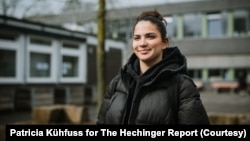Many European countries have programs that help place students in careers at a young age.
In Germany, some students move into education programs at the age of 10. The goal is to prepare them for a lifelong job. They continue their education but also take classes that will help them learn about their job. By the age of 16, those students are placed into work experience programs called apprenticeships.
The system helps keep unemployment among young people low. Groups in the U.S. have expressed interest in the system. They are concerned that the American university system does not prepare young people to enter the workforce.
Some activists and writers such as Ryan Craig say, “many of the best jobs (the U.S.) has to offer don’t require a college education.” But in Germany, young people are starting to push back against the vocational track system that has been in place in one form or another for hundreds of years.
Career training
In the German state of North Rhine-Westphalia, students like Neriman Raim are learning more about jobs before getting on a career track.
Raim is 16 years old. She now believes she wants to work with children. But at first, she thought she wanted to work in an office. She did an internship two years ago at an architecture office, but she found that she did not enjoy the work. Then, she was placed at a school and worked with children in kindergarten. She discovered that she did not like working with young children. “I could see what a day is like with kids,” she said.
The next school year, she spent three weeks working with older children, helping them finish assignments after school. She felt good about that experience. When she finishes school later this year, she will move into a one-year program that will help her decide if teaching will be the right job for her.
The program is called “no graduation without connection.” Students like Raim get help with resumes and job applications. They receive direction starting in ninth grade. By 10th grade, they can get work experience one day per week for the whole school year.
Sonja Gryzik is a teacher at Raim’s school, which is called Ursula Kuhr. “You don’t learn about a job in school,” she said. “You have to experience it.”
A history of vocational training
While the German system keeps youth unemployment low, critics have said for years that it does not work well for low-income students and immigrants. They say students from those families are pushed into vocational studies and not helped to move on to higher education. In addition, some say that recent immigrants are not told how to get into the training programs.
Another criticism of vocational training is that during the COVID-19 pandemic, most of those classes shut down. At the same time, university classes continued by video and students did not lose too much.
Studies in Germany show that problems with vocational training have led more students to university educations. However, up to 28 percent of students do not finish their studies. The number is up to 50 percent for students in humanities and sciences.
Education reform
People involved in education policy in Germany are concerned about the high failure rate. So, they are aiming to reform the vocational training system. Raim’s program is one of the new ones, where students have more choices when deciding on a career, and more chances for exploration before entering a career studies program.
Bernhard Meyer is a teacher at Raim’s school who manages the new program for 11 towns in northwestern Germany. “We have every type of possibility,” he said, noting that students have more choices than just “apprenticeship or university.”
Students in Raim’s program can complete their general education and also start a career they feel good about. It is unusual for students in higher-level academic high schools called gymnasiums to bypass university studies, but it does happen.
Tim Becker, 20, is one of those students. He took a university entrance exam at his high school in Cologne. But instead of starting his studies, he is doing an information technology apprenticeship. Becker said his parents were “uneasy” about his choice. They expected him to go on to higher education. But in school, he said he liked hands-on work more than academic theory.
“I am just not that guy that likes to sit all day in any lectures at some university,” Becker said. He added that some of his old classmates left their universities to start internships.
The students at Ursula Kuhr and their parents attend meetings several times per year. As they learn more, parents feel better about the career choices of their children. Mile Glisic is 15. He is working at a hardware store and considering an apprenticeship in sales. He said his parents had questions about his career ideas, “but I know that they were very happy with it.”
Raim’s mother said she loved the idea that her daughter would teach in a grade school. And Raim said the teachers help their students gain confidence. “They don’t want anyone to finish school and have nothing.”
Other European countries are struggling with the same questions. Camilla Hutters is head of the National Center for Vocational Education, a research organization in Denmark. She said the country has a shortage of workers in fields that offer vocational training to young people.
That only became a problem starting after the 1990s. That is when Denmark scored poorly on an international education ranking list and more students started thinking about college. But now, Danish students as young as six are being shown different jobs so they can start thinking about a career path.
Hutters said programs are starting to make practical learning part of school in the early grades and continuing it through college. Danish leaders are asking universities to work with businesses.
College degrees are still the goal for many Danish students and their parents, “so there is a little bit of mixed tendency…in Denmark,” Hutters said.
More young people in Denmark might take the path of Becker in Germany. He earns over $1,300 per month during his information technology internship and will be ready for a job as soon as September.
Becker said it is nice to be able to get paid to learn, unlike some of his friends who are at a university. He said, “You don’t need to sit all day in university and go to work in the evening to pay your bills.”
I’m Dan Friedell. And I’m Jill Robbins.
Dan Friedell adapted this story for Learning English based on a report by Frieda Klotz for the Hechinger Report. This story was produced by The Hechinger Report, a nonprofit, nonpartisan news outlet focused on education.
____________________________________________________
Words in This Story
career –n. the path that a person takes of the course of their work life or their profession
apprenticeship –n. a period when a trainee works with an established tradesperson to get experience in a trade
track –n. a path often related to jobs in which a person follows that narrowly prepares them for the work ahead
internship –n. a training period at an established organization in which a young person works for little or no money in exchange for job experience
resume –n. a short document that outlines the work experience of a person applying for a job
confidence –n. the feeling that you can do something the right way
practical –adj. something that is related to real-life problems and is not theoretical or political
tendency –n. the likely direction of thought or movement
We want to hear from you. At what age do students explore careers where you live? Do you think the system works well?















Forum